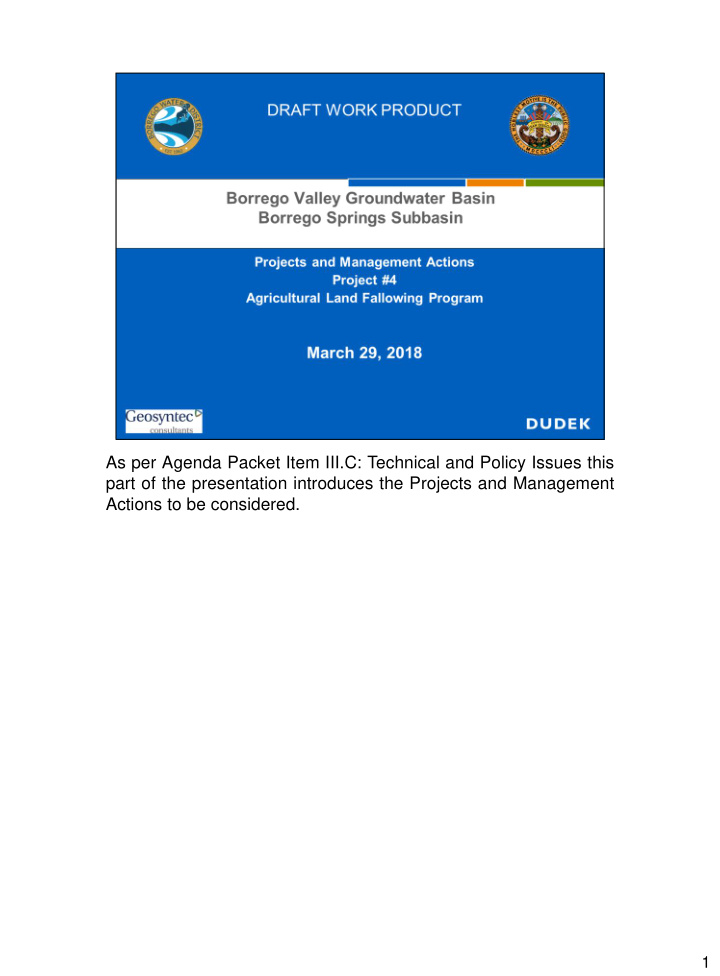



As per Agenda Packet Item III.C: Technical and Policy Issues this part of the presentation introduces the Projects and Management Actions to be considered. 1
For the purposes of the Borrego Valley Groundwater Subbasin (Subbasin) Agricultural Land Fallowing Program (Fallowing Program), fallowing is defined as the conversion of high water use irrigated agriculture to low water use agriculture, open space, public lands, or development. Based on aerial imagery, there is approximately 3,373 acres of active agricultural land in the northern portions of the Subbasin (North Management Area). Substantial fallowing must occur to bring the Subbasin into sustainability. Funding may be available through the 2018 Water Bond or other grant opportunities. 2
The Subbasin has historically fallowed approximately 2,483 acres of agricultural land. As of 2006, approximately 560 additional acres has been fallowed as a part of the water credit program. Best management practices for the Fallowing Program will rely on observations and lessons learned from previously fallowed sites. It is important to remember that fallowing has occurred in the Subbasin for decades. 3
Future fallowing will need to consider environmental impacts such as airborne emissions. Rositas fine sand underlies the majority of the agricultural area in the north of the Subbasin. Although fine sand takes a considerable amount of wind energy to mobilize into the air, as compared to playa and dry lake deposits, the loss of vegetation due to fallowing will likely result in some degree of additional airborne emissions. The windrose diagram (shown in green) shows wind direction and frequency for a meteoblue station located near the town of Borrego Springs. The primary wind direction is from the west with winds speeds ranging from >3 to >12 mph. Thus, the prevailing wind direction will likely blow airborne emissions to the east in the direction away from Borrego Springs. Identifying primary wind directions and soil type will be an important aspect to address airborne emissions conditions and occurrence. The Fallowing Program will need to provide best management practices (BMPs) to stabilize areas where agriculture will be removed. 4
A short term approach to land stabilization is the use of onsite mulching or a bonded fiber matrix. Mulching of existing onsite trees, which has already occurred in the Subbasin, can cost from $1,000 to $10,000 per acre. An alternative to mulching is the bonded fiber matrix, which has not be historically used in the Subbasin and can cost up to $10,000 to $15,000 per acre. 5
Mulching has historically occurred and consist of cutting and chipping trees to spread across fallowed land. Mulching can provide soil stabilization for dust emissions, act as a mulch to conserve water, and reduce weed growth. Pictured above is an example of an area that has not been mulched where weeds have inundated the site. The second example has been mulched and limited weed growth has occurred. Mulching would be used in lie of a final land use plan for the fallowed area. 6
One long term option for fallowed land is land restoration. Desert and highly disturbed agricultural lands possess challenges for successful land restoration. Highly unpredictable weather, low precipitation, excessive heat and drought, and the remote site locations are all challenges faced in desert restoration. Additionally, highly disturbed agricultural lands often exhibit conditions which make land restoration challenging. These conditions include, soil compaction, hydrological modifications, weed infestation, soil quality degradation, and potential pesticide contamination. 7
Typical restoration can be either active or passive. Active restoration is a labor intensive and expensive option which can provide good results in a shorter timeframe as compared to passive restoration. Passive restoration includes the “priming” of land in order to allow for natural processes to restore the land. A passive approach takes considerably longer than active restoration but can be done for a lower cost. 8
In order to ensure fallowed land does not possess environmental issues in the future, best management practices (BMPs) will be developed as a part of the Fallowing Program. Some environmental concerns associated with past land use may be, pesticide use, groundwater contamination, the safety of agricultural infrastructure and equipment, removal of well equipment, and abandonment of wells. Typically, preliminary environmental site assessments are conducted for transfers of land at the commercial scale; similar assessments may be required for fallowed sites. 9
A set of adaptable guidelines will need to be developed in order to provide site specific approaches to land fallowing. The end land use goal will likely determine the level of requirements for land fallowing. 10
Recommend
More recommend